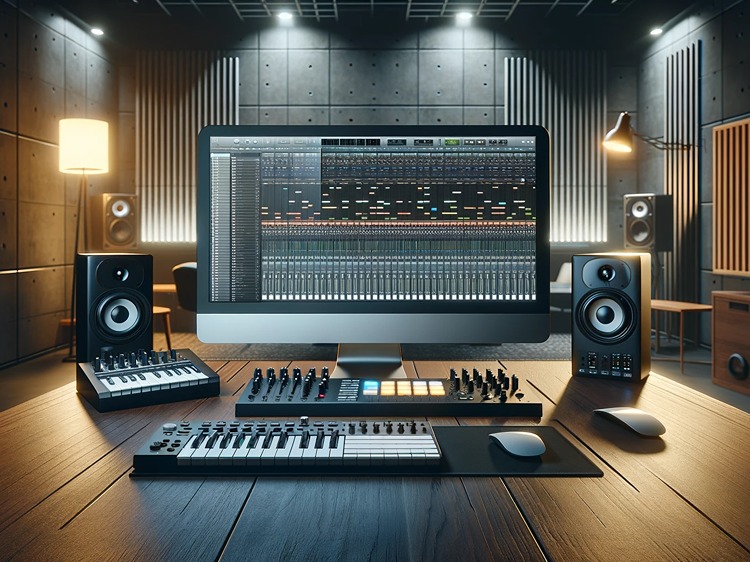As we soar into 2024, the landscape of music production continues to evolve at an exhilarating pace. Gone are the days when creating studio-quality music was confined to the realms of expensive recording studios. Now, in the comfort of your home, with a laptop and a spark of creativity, you can produce tracks that could rival any top-charting artist. The catalyst for this revolution? Music production software. These digital powerhouses are the heart of modern music creation, offering tools and features that turn musical dreams into audible realities. Whether you’re an up-and-coming producer or an established artist, finding the right software is key to your musical journey.
Criteria for Choosing Music Production Software
Before we jump into the reviews, let’s set the stage on what to look for in music production software:
- User Interface: Is it intuitive and conducive to a smooth workflow?
- Feature Set: What tools and capabilities does it offer?
- Compatibility: Does it work well with your existing setup?
- Flexibility: Can it adapt to various music styles and production techniques?
- Support and Community: Is there a strong user base and resources for learning?
Ableton Live 12 – The Live Performance Maestro
Ableton Live, now in its 12th iteration, continues to be a favorite among electronic musicians, especially those who blend studio production with live performances. Its unique Session View offers an unparalleled approach to music arrangement and improvisation. Whether it’s crafting intricate electronic tracks or performing live with loops and samples, Ableton Live 12 stands out for its versatility and fluidity.
Key Features:
- Seamless MIDI integration and controller support
- Advanced sampling and warping capabilities
- Extensive sound library and third-party plugin compatibility
Logic Pro X 10.7 – The Composer’s Paradise
Apple’s Logic Pro X remains a top choice for composers and producers seeking a robust, all-in-one DAW. The latest version, 10.7, introduces new features that enhance its already impressive suite of tools for composing, recording, and mixing. With its user-friendly interface and comprehensive sound library, Logic Pro X is ideal for those who want a blend of simplicity and depth.
Highlights:
- Extensive library of virtual instruments and loops
- Powerful mixing and mastering tools
- Advanced scoring and composition features
FL Studio 21 – The Beat Maker’s Dream
FL Studio, renowned for its user-friendly sequencing and beat-making capabilities, continues to be a staple for hip-hop, EDM, and pop producers. Version 21 builds upon its legacy with enhanced sample manipulation, a revamped mixer, and improved MIDI functionality, making it a top choice for those who prioritize rhythm and beat in their productions.
Standout Features:
- Intuitive pattern-based workflow
- Powerful piano roll for intricate MIDI editing
- Expansive plugin and VST support
Pro Tools 2024 – The Industry Standard
Pro Tools has long been regarded as the industry standard for professional recording and mixing. The 2024 version maintains this legacy, focusing on high-quality audio processing and seamless collaboration features, ideal for high-end studio environments and audio engineers.
Notable Aspects:
- Advanced audio recording and editing capabilities
- High-quality plugin suite and AAX support
- Collaborative features for team projects
Steinberg Cubase 12 – The All-Rounder
Cubase, developed by Steinberg, is another powerhouse in the DAW market. Known for its balance between functionality and ease of use, Cubase 12 excels in music production, scoring, and sound design. Its comprehensive set of tools caters to both beginners and seasoned professionals.
Key Highlights:
- Versatile MIDI and audio editing tools
- Integrated scoring and notation
- Vast array of virtual instruments and effects
Additional Noteworthy Contenders
While the aforementioned software are the giants of the industry, there are several other DAWs that deserve recognition for their unique features and user bases:
- Presonus Studio One: Known for its drag-and-drop workflow and robust mixing capabilities.
- Bitwig Studio: Favoured for its modular design and flexible environment.
- Cockos Reaper: A budget-friendly option with a highly customizable interface.
Choosing the Right DAW for You
Deciding on the right DAW can be a personal journey. Your choice should align with your music style, workflow preferences, and long-term goals. Remember, the best DAW is the one that feels right for you, helping you translate your musical ideas into reality with ease and creativity.
FAQs
- What is a DAW?A DAW, or Digital Audio Workstation, is software used for recording, editing, and producing audio files.
- Can I switch between different DAWs?Yes, you can switch between DAWs, but there might be a learning curve as each has its unique workflow and features.
- Is it necessary to have musical knowledge to use a DAW?While having musical knowledge is beneficial, many DAWs are designed with intuitive interfaces suitable for beginners.
- Do DAWs come with built-in instruments?Most DAWs come with a range of built-in virtual instruments and effects.
- Can I use external plugins with a DAW?Yes, most DAWs support external plugins, expanding your creative possibilities.
Bottom Line
In 2024, music production software continues to redefine the boundaries of creativity and accessibility in music creation. Whether you’re drawn to the live performance capabilities of Ableton, the compositional prowess of Logic, or the beat-making ease of FL Studio, there’s a DAW out there that fits your creative pulse. The journey to find the right one is a path of discovery, leading you to the tool that resonates with your musical voice and vision.

